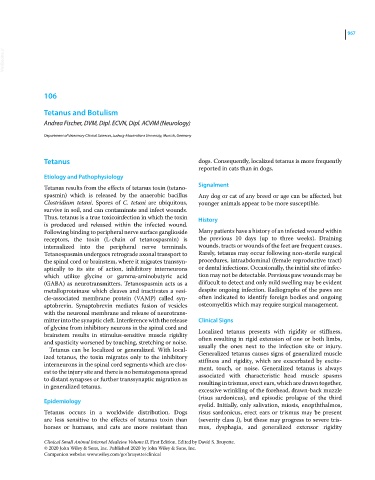Page 1029 - Clinical Small Animal Internal Medicine
P. 1029
967
VetBooks.ir
106
Tetanus and Botulism
Andrea Fischer, DVM‚ Dipl. ECVN, Dipl. ACVIM (Neurology)
Department of Veterinary Clinical Sciences, Ludwig‐Maximilians University, Munich, Germany
Tetanus dogs. Consequently, localized tetanus is more frequently
reported in cats than in dogs.
Etiology and Pathophysiology
Tetanus results from the effects of tetanus toxin (tetano- Signalment
spasmin) which is released by the anaerobic bacillus Any dog or cat of any breed or age can be affected, but
Clostridium tetani. Spores of C. tetani are ubiquitous, younger animals appear to be more susceptible.
survive in soil, and can contaminate and infect wounds.
Thus, tetanus is a true toxicoinfection in which the toxin History
is produced and released within the infected wound.
Following binding to peripheral nerve surface ganglioside Many patients have a history of an infected wound within
receptors, the toxin (L‐chain of tetanospasmin) is the previous 10 days (up to three weeks). Draining
internalized into the peripheral nerve terminals. wounds, tracts or wounds of the feet are frequent causes.
Tetanospasmin undergoes retrograde axonal transport to Rarely, tetanus may occur following non-sterile surgical
the spinal cord or brainstem, where it migrates transsyn- procedures, intraabdominal (female reproductive tract)
aptically to its site of action, inhibitory interneurons or dental infections. Occasionally, the initial site of infec-
which utilize glycine or gamma‐aminobutyric acid tion may not be detectable. Previous paw wounds may be
(GABA) as neurotransmitters. Tetanospasmin acts as a diifucult to detect and only mild swelling may be evident
metalloproteinase which cleaves and inactivates a vesi- despite ongoing infection. Radiographs of the paws are
cle‐associated membrane protein (VAMP) called syn- often indicated to identify foreign bodies and ongoing
aptobrevin. Synaptobrevin mediates fusion of vesicles osteomyelitis which may require surgical management.
with the neuronal membrane and release of neurotrans-
mitter into the synaptic cleft. Interference with the release Clinical Signs
of glycine from inhibitory neurons in the spinal cord and Localized tetanus presents with rigidity or stiffness,
brainstem results in stimulus‐sensitive muscle rigidity often resulting in rigid extension of one or both limbs,
and spasticity worsened by touching, stretching or noise. usually the ones next to the infection site or injury.
Tetanus can be localized or generalized. With local-
ized tetanus, the toxin migrates only to the inhibitory Generalized tetanus causes signs of generalized muscle
stiffness and rigidity, which are exacerbated by excite-
interneurons in the spinal cord segments which are clos- ment, touch, or noise. Generalized tetanus is always
est to the injury site and there is no hematogenous spread associated with characteristic head muscle spasms
to distant synapses or further transsynaptic migration as resulting in trismus, erect ears, which are drawn together,
in generalized tetanus.
excessive wrinkling of the forehead‚ drawn‐back muzzle
(risus sardonicus), and episodic prolapse of the third
Epidemiology
eyelid. Initially, only salivation, miosis, enopththalmos,
Tetanus occurs in a worldwide distribution. Dogs risus sardonicus, erect ears or trismus may be present
are less sensitive to the effects of tetanus toxin than (severity class I), but these may progress to severe tris-
horses or humans, and cats are more resistant than mus, dysphagia, and generalized extensor rigidity
Clinical Small Animal Internal Medicine Volume II, First Edition. Edited by David S. Bruyette.
© 2020 John Wiley & Sons, Inc. Published 2020 by John Wiley & Sons, Inc.
Companion website: www.wiley.com/go/bruyette/clinical

